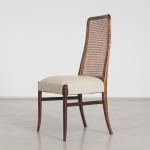



Joaquim Tenreiro
Solid Rosewood, Cane, Leather
H 40.55 in. x W 20.08 in. x D 21.66 in.
Further images
Joaquim Tenreiro (1906-1992) was a forerunner in the use of rediscovered raw materials. He drew on the lessons of past furniture-making as a vital source in the mastery of technical and constructive solutions and his production's aesthetic experience, craftsmanship, and cultural meaning.
These dining chairs are made of solid Rosewood with soft leather seats and long cane backrests. The lightness so desired in Tenreiro's designs is reached through the delicately sculpted curves, which combine with the stunning rosewood colors in rounded shapes.
"When I was making furniture, the plaited cane had almost disappeared in Brazil; nobody used it. I retrieved cane from the colonial tradition. Cane originally came from India and had become a tradition in Brazil. Brazil used a cane for years. It served the purpose of the climate, mainly because of the heat in Rio de Janeiro and even in São Paulo. Cane was a necessary element in modern furniture."
Joaquim Tenreiro, 1985.



